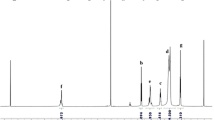Abstract
Purpose. The aim of this study was to control the release of charged drugs from gels by adding surfactants that can interact with the drug and polymer matrix.
Methods. The in vitro release from gels was measured by using 6-mL gel holders immersed in 250 mL of simulated tear fluid and detecting the ultraviolet absorbance on-line. Gels were characterized by using a controlled rate rheometer, and surfactant aggregates were characterized by using cryo-transmission electron microscopy.
Results. The diffusion coefficient of alprenolol was 2.8 · 10−6 cm2/s in a lipophilically modified poly(acrylic acid) gel without surfactants present and 0.14 · 10−6 cm2/s when formulated with 1% sodium dodecyl sulfate. For fluvastatin, the diffusion coefficient changed from 3.0 · 10−6 cm2/s to 0.07 · 10−6 cm2/s in the presence of 0.2% benzyldimethyldodecyl-ammonium bromide. Alprenolol, betaxolol, metoprolol, diphenhydramine, and fluvastatin formed vesicles with oppositely charged surfactants in physiologic salt conditions.
Conclusions. In this article we show that it is feasible to control the release of charged drugs from gels by using surfactants. Vesicles are generally formed when surface active drugs are mixed with oppositely charged surfactants in physiologic conditions. The strongest effects on the release rate are seen for lipophilically modified polymer gels in which the drug and the oppositely charged surfactant form vesicles, but systems with micelles also give a slower release.
Similar content being viewed by others
REFERENCES
S. D. Desai and J. Blanchard. Pluronic F127-based ocular delivery system containing biodegradable polyisobutylcyanoacrylate nanocapsules of pilocarpine. Drug Deliv. 7:201-207 (2000).
A. Paavola, I. Kilpeläinen, J. Yliruusi, and P. Rosenberg. Controlled release injectable liposomal gel of ibuprofen for epidural analgesia. Int. J. Pharm. 199:85-93 (2000).
H. Sjöberg, S. Persson, and N. Caram-Lelham. How interactions between drugs and agarose-carrageenan hydrogels influence the simultaneous transport of drugs. J. Control. Release 59:391-400 (1999).
M. Paulsson and K. Edsman. Controlled drug release from gels using surfactant aggregates. I. Effect of lipophilic interactions for a series of uncharged substances. J. Pharm. Sci. 90:1216-1225 (2001).
J. Carlfors, K. Edsman, R. Petersson, and K. Jörnving. Rheological evaluation of Gelrite in situ gels for ophthalmic use. Eur. J. Pharm. Sci. 6:113-119 (1998).
J. Stjernschantz and M. Astin. Anatomy and physiology of the eye. Physiological aspects of ocular drug therapy. In P. Edman (eds.), Biopharmaceutics of Ocular Drug Delivery, CRC Press, Boca Raton, 1993 pp. 1-25.
W. I. Higuchi. Analysis of data on the medicament release from ointments. J. Pharm. Sci. 51:802-804 (1962).
P. L. Ritger and N. A. Peppas. A simple equation for description of solute release I. Fickian and non-fickian release from nonswellable devices in the form of slabs, spheres, cylinders or discs. J. Control. Release 5:23-26 (1987).
M. Paulsson, H. Hägerström, and K. Edsman. Rheological studies of the gelation of deacetylated gellan gum (Gelrite) in physiological conditions. Eur. J. Pharm. Sci. 9:99-105 (1999).
M. Almgren, K. Edwards, and G. Karlsson. Cryo transmission electron microscopy of liposomes and related structures. Colloid. Surface A 174:3-21 (2000).
I. Harwigsson, O. Söderman, and O. Regev. Diffusion and cryo-transmission electron-microscopy studies of bicontinuous micellar solutions. Langmuir 10:4731-4734 (1994).
N. J. Turro and A. Yekta. Luminescent probes for detergent solutions: a simple procedure for determination of the mean aggregation number of micelles. J. Am. Chem. Soc. 100:5951-5952 (1978).
M. Vasilescu, D. F. Anghel, M. Almgren, P. Hansson, and S. Saito. Fluorescence probe study of the interactions between nonionic poly(oxyethylenic) surfactants and poly(acrylic acid) in aqueous solutions. Langmuir 13:6951-6955 (1997).
A. M. Gerakis, M. A. Koupparis, and C. E. Efstathiou. Micellar acid-base potentiometric titrations of weak acidic and/or insoluble drugs. J. Pharmaceut. Biomed. 11:33-41 (1993).
O. Regev, E. F. Marques, and A. Khan. Polymer-induced structural effects on catanionic vesicles: formation of faceted vesicles, disks, and cross-links. Lamgmuir 15:642-645 (1999).
S. Nilsson, M. Goldraich, B. Lindman, and Y. Talmon. Novel organized structures in mixtures of a hydrophobically modified polymer and two oppositely charged surfactants. Langmuir 16: 6825-6832 (2000).
D. Attwood and S. P. Agarwal. The surface activity and self-association of some beta-adrenoceptor blocking agents in aqueous solution. J. Pharm. Pharmacol. 31:392-395 (1979).
A. Lindahl, B. Persson, A.-L. Ungell, and H. Lennernäs. Surface activity and concentration dependent intestinal permeability in the rat. Pharm. Res. 16:97-102 (1999).
D. Attwood and O. K. Udeala. The surface activity of some antihistamines at the air-solution interface. J. Pharm. Pharmacol. 27:754-758 (1975).
Author information
Authors and Affiliations
Rights and permissions
About this article
Cite this article
Paulsson, M., Edsman, K. Controlled Drug Release from Gels Using Surfactant Aggregates. II. Vesicles Formed from Mixtures of Amphiphilic Drugs and Oppositely Charged Surfactants. Pharm Res 18, 1586–1592 (2001). https://doi.org/10.1023/A:1013086632302
Issue Date:
DOI: https://doi.org/10.1023/A:1013086632302




